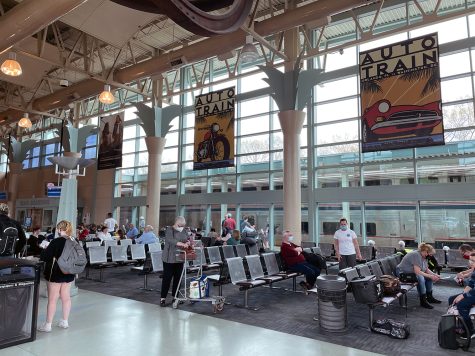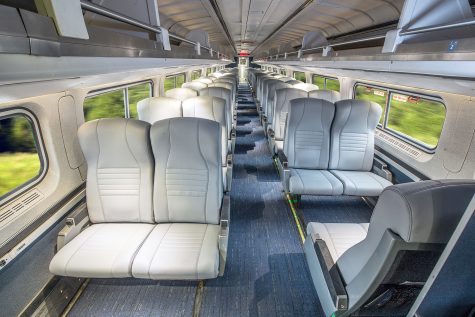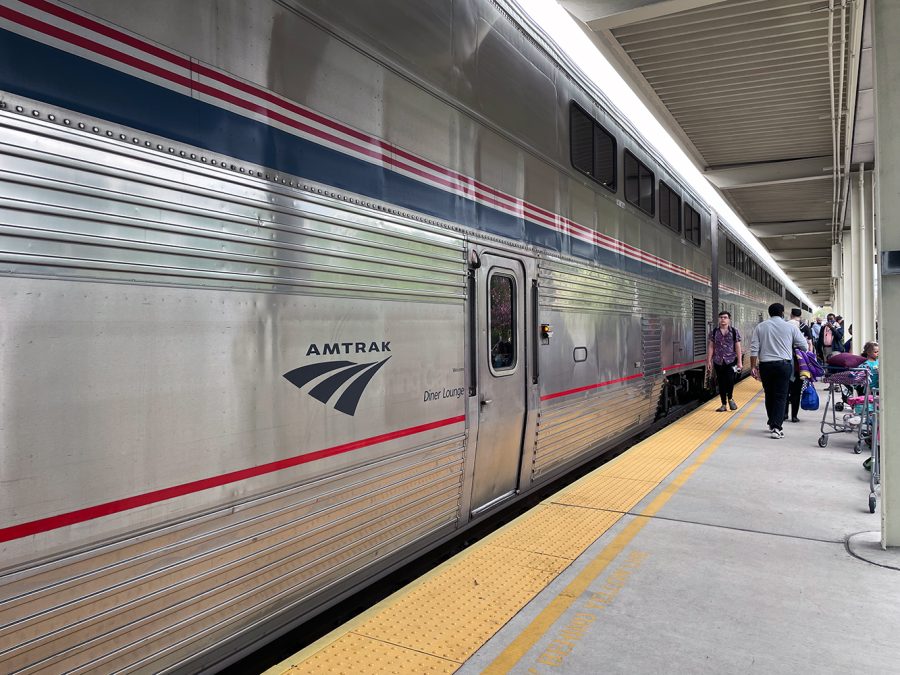Opinion: The Rail World
Though common in other parts of the world, train travel in the U.S. is an under-appreciated experience.
The Amtrak passenger cars before passenger board.
May 6, 2022
Over spring break, airplanes fill up quickly with everyone traveling for vacation during the time off from school. One of the most popular vacation destinations is Florida, and those flights max out months before the season begins. Others decide to drive or stay home to avoid crowded airports, but there is another method of travel that may be superior to planes and cars.
Traveling via train is very popular and efficient in other parts of the world, such as Europe and Asia. Japan, for example, is famous for its Bullet Train that travels at 199 miles per hour, and anyone who has traveled to Europe knows that it’s often not necessary to use a car as train travel is easy and affordable. The United States offers train travel as well, but it is less popular and convenient than it is in other areas.
The Amtrak Train Corporation has 21,000 route miles of track in 46 states, the District of Columbia, and three provinces in Canada.
Over spring break, my family, like many others, decided to go to Florida for vacation. But we did not fly or drive down — we took the Amtrak train. This was my fourth time traveling to Florida on a train, and I would readily do it again.
Of course, traveling by train has its cons. One of the biggest factors deterring people from choosing train travel is time. A plane ride from Pittsburgh to Miami is two-and-a-half hours non-stop. The time spent traveling by train is significantly longer.
The trip I took from Lorton, Virginia to Sanford, Florida was at least 17 hours without stopping or delays. There is an Amtrak Station in Pittsburgh, but it does not have the automobile train boarding amenity that the station on Lorton has. 
The Amtrak Train station in Lorton, Virginia. So if you are in a rush, trains in the United States are not for you, but if you have the time, taking a train gives you the opportunity to see things you cannot see on a plane. In fact, at the beginning of the journey the conductor will make announcements telling passengers what towns they are traveling through and fun facts about them.
Additionally, unlike airplanes, trains are much less cramped. Both have overhead storage for luggage, but if you want legroom on a plane it usually involves paying extra and personal space is limited. But on a train coach, legroom is three times greater than it is on planes, and the chairs recline more, making it the long journey more comfortable.
There is optimal space to stand up and walk around during the ride. Passengers can walk to the dining car to get food or go to the observation car to get a better view of the surroundings.
Another perk of traveling via train is that some Amtrak trains allows passengers to bring their car on board the train with them. Before passengers board, they can drop their car off to be loaded into the back of the train. Those trains can hold 200 to 300 vehicles, which is something a plane clearly cannot do.
One of my personal favorite parts about trains is the sleeper cars, which are equipped with two chairs that face each other and a foldable table in the center. But when it gets dark and it is time to sleep, the cabin turns into a bunk bed, making the experience more comfortable.

Another positive side to traveling by train is the environmental impact. Train travel produces half the amount of carbon dioxide as air travel. Trains are designed to carry more passengers than planes, so the per capita emissions are much lower than the per capita emissions of planes.
I have traveled to Florida by plane, train, and car, and I believe taking a train is the best option. Even though it takes longer, it is an uncommon experience that most Americans will most likely delight in.












